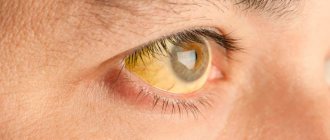Pain in the eyes is probably familiar to everyone. The nature of this pain may differ depending on the cause that caused it. In this article we will look at situations where pain occurs when moving the eyeballs.
Sometimes the eyes begin to hurt at the moment when a person rotates them, tries to look to the side or up. This symptom often occurs unexpectedly and can indicate either ordinary visual fatigue or more serious pathologies.
Causes of headaches
Headache can be a manifestation of many diseases; diagnosis of the disease is associated with additional symptoms. This is due to the fact that there are many structures in the brain that can be affected by pathology. For example, body temperature may rise, which indicates an infectious process in the brain. Pain in the eyes can occur when intracranial pressure increases. Here are the reasons that can lead to headaches:
1. If there is a temperature, this means that meningitis or encephalitis may develop.
2. Pain in the eye area as an accompanying symptom can indicate fatigue and be a sign of stress and overwork.
3. If your eyes hurt, it could be a migraine.
4. If your head hurts when you turn your head, and your neck bothers you, then this is a sign of osteochondrosis of the cervical spine.
5. Signs may indicate neurological disorders such as acute cerebrovascular accident or traumatic brain injury, as well as a brain tumor.
6. Hypertensive crisis or increased pressure.
7. Symptoms may indicate ophthalmological pathology.
Many abnormalities are characterized not only by pain in the organ of vision, but also by a phenomenon where the eye twitches. This may be a sign of various abnormalities, both infectious and inflammatory in nature.
As you can see, there are many causes of pain, and they need to be understood individually.
Why and how your eyes hurt when you move them
The reasons why it is painful to move the eyeballs are various diseases associated with the organ of vision or the structures surrounding it. Sometimes the eyes can hurt when turning left and right due to overwork of the muscles that hold them. This happens when working at a computer for a long time or observing something.
Eyes hurt at the end of the day if a person uses unsuitable contact lenses. They cause irritation of the mucous membrane and drying out of the cornea.
It may be difficult to move your eyes after welding. Tension of this organ occurs, and a burn to the mucous membrane or cornea is also possible if safety glasses are not used.
Vision problems
Most often, it is difficult to move the eyes precisely because of an ophthalmological disease:
- Conjunctivitis. This disease is accompanied by redness and swelling of the mucous membrane. A clear or purulent discharge appears. It becomes painful due to irritation of the inflamed mucous membrane.
- Barley. This is an inflammation of one lacrimal gland located on the upper or lower eyelid. It swells and a tense lump forms. It makes it painful to raise or lower your eyes up or down.
- Blepharitis. This is the name for inflammation that occurs along the edges of the eyelids. At the same time, they become red, swollen, and severe itching appears. It is unpleasant to move the eyeballs due to irritation of the eyelid margins.
- Glaucoma. This disease is associated with increased pressure inside the eyeball. The liquid in it seems to be pressing from the inside, so your eyes hurt when you turn your gaze to the sides.
- Pain may occur due to allergies. This condition is manifested by severe swelling of the conjunctiva, severe itching, and lacrimation. It hurts to move the eyes due to swelling.
If a person has poor vision, and the lenses for glasses are chosen incorrectly, then he constantly has to strain his eye muscles in order to see normally. This leads to the fact that by the end of the day it becomes painful for a person to move his eyes.
Not related to vision
It happens that it is painful to move and move the eyes not because of their pathology, but because of diseases of nearby structures.
- Migraine. This is a severe headache that makes it painful to look and turn your eyes. Usually the pain occurs on only one side.
- Sinusitis is inflammation of the maxillary sinuses. The mucous membrane swells and pus accumulates. There is pressure on the eye socket, so moving the eyes can be painful.
- Frontit. This is a disease similar to sinusitis, but is manifested by inflammation of the frontal sinuses, which are located above the eye sockets. Frontal sinusitis and sinusitis are characterized by an increase in body temperature.
- Infectious diseases. During a cold, the muscles of the eyes often hurt when they move. This is due to high fever and intoxication.
- Injuries to the bones of the skull. Even with outwardly invisible injuries, a person’s eyes hurt when he looks around. Such sensations are associated with tissue swelling and damage to nerve endings.
If the pathology is not associated with damage to the eyeballs, it has manifestations in other organs.
Symptoms of various pathologies
To diagnose the disease, it is important to look at the signs of various abnormalities.
The symptoms of meningitis are quite characteristic: severe headache, body temperature increased to 39-400, a person can tell up to the minute when it appeared. Nausea, weakness, and signs of rapidly increasing intoxication occur. One of the forms of manifestation of the pathology is the appearance of a blue-brown rash with blurred edges, in the form of stars. The rash begins from the feet and gradually moves higher. This rash is called meningococcemia; at this stage, a sufficient amount of toxins has already accumulated in the bloodstream. In this case, the temperature drops very poorly and is a sign of attempts by the immune system to fight abnormalities.
Ophthalmological causes of pain
Under certain circumstances, when it is painful to move your eyes, these sensations cause a headache as a chain reaction.
If the eyeballs hurt, this condition is called ophthalmalgia. This can be manifested by a burning sensation in the eyes, a sensation of a foreign body, when they water, the image before the eyes is blurred, the sclera is red. Unpleasant sensations intensify when moving the head. The causes of such pain have not been precisely established.
The second reason is an inflammatory process (conjunctivitis or blepharitis), while the eyes are red and very watery. Purulent contents are released from the mucous membrane. One or both eyes may be affected, and the temperature usually does not increase.
When a person sees poorly with the right or left eye, this is a consequence of an eye injury, which the person may not pay attention to. A sharp decrease in vision begins in one eye, which requires correction with glasses. At the same time, intraocular pressure increases, which is fraught with other complications.
Causes of pain when moving the eyes
One of the main causes of pain in the eyes is muscle overstrain. Most often they occur during long periods of work at the computer or when concentrating on a specific object. Getting rid of pain in this case is quite simple. It is enough to let your eyes relax and rest.
Pain during eye movements can also be caused by:
Conjunctivitis
Discomfort during eye movements in people with this disease is always combined with other symptoms. These include redness of the mucous membranes of the sclera, a feeling of sand, sensitivity to light, and tearfulness. The development of conjunctivitis can be triggered by an infection, virus, allergy, or injury.
Uveitis
This term refers to inflammation in the blood vessels of the eyes. In some cases, uveitis may only manifest itself as pain when moving the eyeballs to the sides. Sometimes symptoms include intolerance to bright light, blurred vision, and tearfulness. Without proper treatment, the pathology can cause complete loss of vision.
Iritis
Another pathology of an inflammatory nature, during which the iris of the eye suffers. In addition to pain, swelling, blurred vision, and redness of the sclera may also be observed. The pain is quite severe, spreading to the area of the eyebrows and nose. Allergies and infections can trigger the development of iritis.
Xerophthalmia
This pathology develops due to insufficient tear production. Most often it is diagnosed in older people. In their case, xerophthalmia is associated with the natural processes of aging of the body. In young people, dry eyes can be associated with other pathologies or be a manifestation of vitamin deficiency, eye strain or eye fatigue. In addition to pain when rotating the eyeballs, xerophthalmia is manifested by burning and dryness, sensitivity to light, and sensations of foreign objects in the orbit.
Neuritis
This pathology is accompanied not only by pain when rotating the eyes, but also by a significant decrease in visual abilities. Patients with a similar diagnosis develop blind spots in the field of vision, color vision deteriorates, and night blindness develops. In most cases, neuritis is of infectious origin. Its development may be associated with diseases of the ENT organs and teeth.
Glaucoma
The main manifestation of glaucoma is considered to be an increase in intraocular pressure. In the early stages of development, the pathology manifests itself as slight pain in the eye sockets and narrowing of the visual fields. As glaucoma progresses, symptoms may worsen and new ones will be added to existing ones. In particularly advanced cases, increased intraocular pressure can cause complete blindness.
Migraine
During migraine attacks, the headache is often accompanied by pain in the eye sockets. It has a pulsating nature and can spread to the temples and forehead. An attack can last from several hours to several days.
Other reasons
In addition to the above factors, the following can cause pain in the orbit during eye movement:
- ARVI;
- VSD;
- neoplasms;
- infections;
- caries;
- wearing contact lenses.
Neurological group of disorders
Neurological disorders are disorders of the activity of the brain and spinal cord: inflammatory diseases, as well as congenital disorders of the activity of structures, consequences of injuries and damage.
Here are neurological diseases that cause headaches and eye pain:
1. The eyes can be very painful if a person has a migraine. This is a one-sided headache that bothers you when you move your eyeballs and can occur in the morning or throughout the day. Pathology refers to neurological abnormalities. Attacks of visual impairment are frequent: flies flashing before the eyes, the eye sees poorly, usually on the side opposite to the diseased half. During an attack, photophobia and nausea occur, and the attack lasts up to an hour.
2. Poor cerebral circulation is manifested not only by headaches, but also by other symptoms: impaired sensitivity of the limbs in various combinations, impaired speech, and swallowing reflex. If hemorrhagic hemorrhage occurs, the pupils become different sizes and convulsions may appear. The cause of stroke is high blood pressure, trauma, and cerebral atherosclerosis.
3. A brain tumor does not appear immediately; symptoms appear only when the growing tumor puts pressure on neighboring brain structures. Headache is a common symptom for all types of brain tumors; it often appears in the morning, intensifies as the disease progresses, can be very painful and suddenly stop. Depending on its location, additional symptoms vary: the eye hurts when the formation is located in the area of the optic nerve, it twitches.
4. In case of head injury, signs of abnormalities can be expressed depending on the complexity of the development of the process. This could be a concussion, which is manifested by dizziness, nausea, and a headache when turning or moving the head. A more complex situation is when a cerebral hemorrhage occurs. Then the symptoms are similar to hemorrhagic stroke.
Ophthalmopathologies in which it is painful to move the eyes
The cause of pain that occurs when moving the eyeballs is often directly related to diseases of the visual system.
- Blepharitis.
Usually, pain when moving appears in the late stages of inflammation, when the pathological process has spread from the eyelids to the entire eyeball. In this case, the patient can hardly move his eyes, which are very festered and look reddened.
- Neuritis of the oculomotor nerve.
The disease does not occur very often, but one of its characteristic signs is the difficult movement of the eyeballs and the resulting pain.
- Ocular myositis.
With this disease, the external eye muscles become inflamed, which naturally leads to pain when trying to change the direction of gaze. The inflammatory process in the extraocular muscles can be caused by infectious and inflammatory diseases, injuries, intoxications and a number of other reasons.
- Glaucoma.
Sometimes a patient who goes to the doctor with the complaint “it hurts to move the eyes” is diagnosed with “glaucoma.” With this disease, pain in the eye area can “radiate” to the head, accompanied by swelling of the eyelids, vomiting, decreased visual acuity, and changes in pupil size. If a person experiences such symptoms, one should not delay contacting a doctor. Glaucoma is dangerous, first of all, due to irreversible vision loss.









